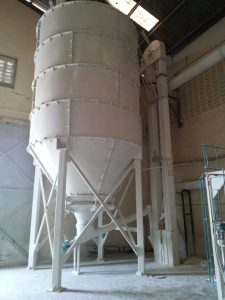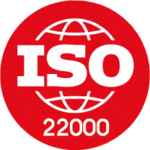Cleaning Frequency of Flour Silos in Malaysia
Factors of flour silos cleaning frequency

The cleaning frequency of flour silos depends on several factors, including the type of flour, storage conditions, and the level of usage. However, here are some general guidelines:
- Regular Cleaning Schedule
- Monthly to Quarterly: For silos that are in continuous use, a cleaning schedule of every 1 to 3 months is common. This helps prevent the buildup of flour residues, which can attract pests or promote mold growth.
- Bi-Annual to Annual: If the silo is used less frequently or if it is well-maintained and pest-free, a cleaning schedule of every 6 to 12 months may be sufficient.
- Condition-Based Cleaning
- After Each Use: If different types of flour are stored in the same silo, it’s crucial to clean it thoroughly after each batch to avoid cross-contamination, especially with allergens.
- After Downtime: If the silo has been idle for an extended period, it should be inspected and cleaned before reuse to ensure no contamination occurred during the downtime.
- Post-Maintenance: After any maintenance work on the silo, a cleaning is necessary to remove any residues or debris introduced during the process.
- Inspection-Triggered Cleaning
- Pest Activity: If there are signs of pest activity (e.g., droppings, insects), an immediate cleaning and pest control intervention is necessary.
- Mold or Moisture: If any signs of mold or moisture are detected, the silo should be cleaned immediately to prevent contamination of the flour.
- HACCP or GMP Requirements
- Compliance-Driven: Some facilities may have specific HACCP or GMP requirements that dictate a more frequent cleaning schedule, depending on the risk assessment and the critical control points identified.
- Post-Spill or Incident Cleaning
- Immediate: Any spills or contamination incidents require immediate cleaning to prevent further contamination or pest infestation.
Best practices
- Record Keeping: Maintain detailed records of all cleaning activities, including dates, methods used, and inspection results. This helps in auditing and ensures compliance with regulatory standards.
- Inspection Before Refill: Always inspect the silo before refilling to ensure that it is clean and free of contaminants.
A regular inspection program should complement the cleaning schedule to identify any issues early and address them before they lead to contamination or other problems.
Guidelines for cleaning flour silos

The guidelines provided for cleaning and maintaining flour silos are based on general best practices within the food industry, particularly those related to HACCP and GMP. These practices are commonly recommended by industry experts and regulatory bodies to ensure food safety and quality.
However, specific references for the exact cleaning schedules are often tailored to individual operations based on risk assessments and are not universally mandated by a single regulation or guideline. They are typically found in:
- HACCP Guidelines and Manuals: These documents provide frameworks for developing specific cleaning schedules based on hazard analysis.
- GMP Guidelines: Often included in regulations or guidance documents provided by food safety authorities such as the Food and Drug Administration (FDA) in the U.S. or the European Food Safety Authority (EFSA).
- Industry Standards and Codes of Practice: Documents from organizations like the International Association for Food Protection (IAFP) or the British Retail Consortium (BRC) Global Standards.
For detailed and specific guidelines, companies often refer to:
- Codex Alimentarius: International food safety standards developed by the Food and Agriculture Organization (FAO) and the World Health Organization (WHO).
- Local Regulatory Requirements: National food safety regulations that may provide specific cleaning intervals for storage facilities.
- Technical Bulletins from Industry Associations: For example, the American Association of Cereal Chemists (AACC) or similar organizations might provide detailed guidance on flour storage and handling.
In Malaysia

In practice, many companies in Malaysia adopt cleaning schedules that are aligned with international best practices, typically ranging from monthly to quarterly cleanings for flour silos, with more frequent cleaning if specific risk (like pest infestation or moisture) are identified.


